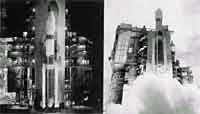Space travails
 the efforts to monitor the world's changing climate from space received a major jolt on June 30 when National Space Development Agency ( nasda ), the Japanese space agency, lost connection with its Advanced Earth Observing Satellite ( adeos ). The agency has also lost a set of vital climate data ( New Scientist , Vol 155, No 2090).
the efforts to monitor the world's changing climate from space received a major jolt on June 30 when National Space Development Agency ( nasda ), the Japanese space agency, lost connection with its Advanced Earth Observing Satellite ( adeos ). The agency has also lost a set of vital climate data ( New Scientist , Vol 155, No 2090).
Officials of nasda say that the solar panels of the satellite stopped functioning after it collided with a piece of space junk. However, there is still no firm evidence of the sudden failure of adeos. The satellite had been carrying eight sensors to monitor changes in the Earth's oceans and atmosphere. Of these, five were Japanese, two from the us , and from France.These included a total Ozone Mapping Spectrometer, used to monitor the destruction of stratospheric ozone by chloroflourocarbons ( cfcs) and other chemicals, and a specific part of the radar equipment called nscat that measured sea surface winds.
The loss of nscat has caused a major set-back to the space agency. Data pertaining to ocean surface winds from the nscat was being used for weather forecasting, says Helen Wood, director of satellite data processing at the us National Oceanic and Atmospheric Administration. During the course of its launch last year, adeos had to use a backup propulsion system to reach its planned orbit. However, the satellite had been performing up to expectations since then.
The Japanese space agency has planned to launch another satellite, adeos-2, in the year 1999, which will carry similar instruments. According to a spokesperson of nasda , the failure of adeos would not delay the launch of adeos-2. However, he adds that there is a need to investigate the accident to assess the cause of adeos's sudden failure. It is pertinent to find out the reason because the design of the solar panels of adeos-2 is the same.
